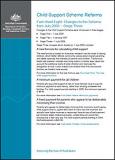Fact sheet Eight: Changes to the Scheme from July 2008 - Stage Three
Changes to the Child Support Scheme were introduced in three stages:
- Stage One - 1 July 2006
- Stage Two - 1 January 2007
- Stage Three - 1 July 2008.
A new formula for calculating child support
The new formula is based on Australian research into the costs of raising children, which better reflects community values about shared parenting and better balances the interests of parents and children. The formula treats both parents' incomes and living costs in a similar way, takes into account the additional costs of older children and improves the recognition of care. It also makes sure children from first and second families are treated more equally.For more information on the new formula see Fact sheet Nine: The new child support formula.
A minimum payment for all children
Parents who pay child support to two or more families have to pay the minimum payment to each family, rather than dividing it between the families. For child support periods starting in 2008, the minimum payment is $6.50.For more information see Fact sheet Twelve: Minimum payments.
A fixed payment for parents who appear to be deliberately minimising their income
Parents who appear to deliberately minimise their income to avoid paying child support (that is, payers who claim to have very low incomes, but actually have higher incomes or resources) have to pay a fixed payment per child per week (indexed annually), unless they can prove their incomes are in fact very low. For child support periods starting in 2008, the fixed payment is $20.50.For more information see Fact sheet Thirteen: Fixed assessments.
Changes to Family Tax Benefit
Parents who have care of a child for more than 65 per cent of the time (238 nights or more) are allowed to keep all the FTB for the child. Under the previous Scheme, the ability to split FTB could be a source of conflict over every percentage point of care. Under the new Scheme, parents who have regular care of a child for 14 per cent to less than 35 per cent of the time (52 to 127 nights per year) have the costs of care recognised through the new formula.For more information see Fact sheet Seventeen: Changes to Family Tax Benefit (FTB).
New treatment of extra income earned after separation
For the first three years after separation, parents will be able to apply to have extra income earned after separation excluded from child support calculations, in certain circumstances.For more information see Fact sheet Fifteen: Extra income earned after separation.
Changes to agreements for child support and lump sum payments
The new Scheme improves the process for parents wishing to make agreements. There is more flexibility for parents who wish to agree on their own child support arrangements, including lump sum payments. In addition, there is better legal protection for parents who want to make long-term agreements and it is easier to make shorter-term agreements.For more information see Fact sheet Eighteen: Child support agreements and lump sum payments.
Simplified processes for parents who want to reconcile
Previously, if parents reconciled and then separated again, the processes for managing a child support liability were complex. This may have been an obstacle to separated parents who wished to attempt reconciliation. The new Scheme allows reconciling parents to put their child support assessment on 'hold' for up to six months. This means that no child support is payable and no debts accumulate during this time.For more information see Fact sheet Sixteen: Simpler child support processes when parents get back together.
Recognition of step-children without other support
Parents who have financial responsibility for a step-child (because no other person can provide support for them) can have the child treated as a dependant when their child support liability is being calculated.For more information see Fact sheet Fourteen: Second families - new arrangements.
Closer alignment of income definitions for child support and Family Tax Benefit (FTB)
The new income definitions for child support and Family Tax Benefit more closely align the treatment of certain tax-free amounts and foreign income.For more information see Fact sheet Nineteen: Alignment of income definitions for child support and Family Tax Benefit (FTB).
Please note this fact sheet is for general guidance only. It should not be treated as a complete or authoritative legal statement.
More details about these changes can be found in other fact sheets and on the Child Support Agency website
More information on the Taskforce and how the reforms started is available on this website under Ministerial Taskforce on Child Support.
Last updated:

